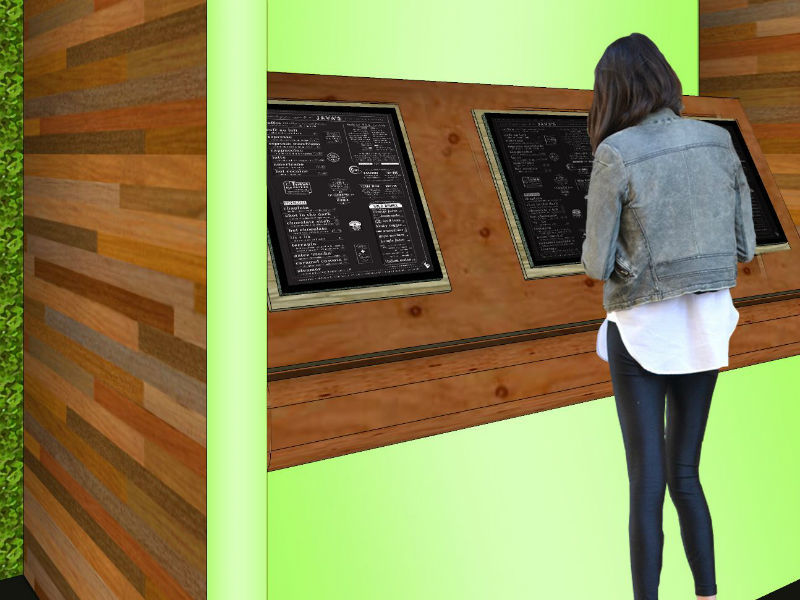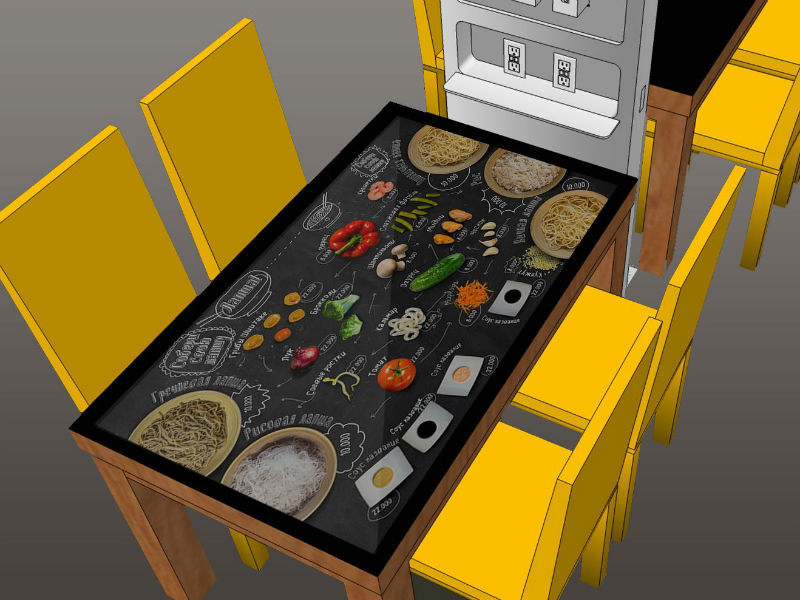Year 2040: What restaurants of the future might look like
- Transfer

In our blog, we talked about how restaurants automate their work using special systems (for example, Jowi ), take care of the comfort of visitors with the right light and sound , and also use psychological tricks to increase the average check.
Today we will focus on how a restaurant could be the future - present to your attention an adapted translation notes Eater.com edition.
To imagine what a democratic restaurant of the future will look like, Vinc Dixon from Eater spoke with restaurant technology experts and an environmental designer.
The collapse of the fast food culture is inevitable. Judging bycurrent trends , traditional fast-food establishments will ultimately be crowded out by democratic restaurants that seek to win the favor of a more picky generation that cares about their health. This can be considered karma for what fast-food chains have done with American restaurants.
Experts believe that in the near future affordable restaurants - something between traditional fast-food restaurants and canteens, if you take into account the price level, style, service and quality of food - will become even more common . One can only guess what will happen to such institutions over the next 25 years, however, current trends suggest certain thoughts.
According to Jeremy Julian and Gary Stotko, also known as Restaurant Businesses , there will be fewer people and more computers in restaurants of the future. As managers of Custom Business Solutions, Inc., a restaurant technology development company, Julian and Stotko are trying to convince restaurant owners that the digital age is confronting them with the inevitable choice: keeping up with the times or losing customers, or even the entire business.
“The owners [of the restaurants] understand that if they don’t use the technology, they will have to raise prices,” says Julian. According to Julian and Stotko, in order to adapt to changes in culture, wage policy and technology, restaurant owners need to start using modern digital tools in their business, such as big data, multi-channel marketing and wearable gadgets. This means that in the modern world restaurant chains can store various types of information about each client, constantly present in their digital life and studying their needs and desires.
Based on this conclusion - as well as statistics, research on current trends - Eater, with the help of an environmental designer and illustrator, tried to imagine what a fast food restaurant would look like in 25 years. Embark on a visual tour of it with us.
Imaginary look into the future
2040 year. Millennials, known for their innovative ideas, are approaching a 50-year milestone; environmentally conscious generation Z gives way to the Alpha generation - high school students and college graduates, who are now focused on the world of marketing. You are standing in front of a new democratic restaurant in your city that sells sandwiches or pasta. Your friend has already been to this place several times, you follow her.
As soon as you pass through the automatic doors to the dining area, you will see a combination of modern design and environmental awareness: walls made from plant materials, bamboo counters, cork tables, solar-powered lamps. All this is emphasized by multi-colored LED lamps. You would be amazed if you didn’t see this shameless attempt to address the eco-trends of the Z generation in such restaurants a million times. From all sides you can hear snatches of conversations, strange electronic signals and energetic melodies of classic hip-hop, which merge into a cacophony and create a relaxing atmosphere.
Your friend takes a smart pad (formerly known as a “phone”) out of her pocket and unlocks the screen. “Glad to see you again,” the message arrives. This is part of the loyalty program in which it participates, as well as many others now. You look up and see a small black “beacon” reading your friend’s smartpad and delivering messages. “You got 10 points! Get 50 more and get a free sandwich! ”
Self-service terminals

Now you need to find free places. You go to the back of the restaurant, where there are cabins with tables, and to your right you notice the self-service terminals. They remind you of the mid-2010s when, due to constant protests caused by wage policies, many fast-food restaurants, in particular McDonald's, have set up self-service terminals .
You understand that the strange electronic signal that you heard comes from the screens of the terminals, where several impatient young people skillfully place an order or pay the bill.
A young woman, standing in front of one of the terminals, brings the smartpad to the screen. "Thanks! Your bill has been paid! ”Number 34 appears on the screen.
A woman walks past you and heads towards a green moss-covered wall with about 50 small compartments. You will recognize these automatic “cells” that were so popular in progressive, fully automated restaurant chains like Eatsa 20 years ago. A woman walks up to cell number 34 and touches the screen / door with her hand. The cell door opens and a woman picks up a brown bag.
Wearable gadgets
You and your girlfriend chose a table in the back of the room. You are about to sit down, but she stops you: "This table is dirty." You see that the table is strewn with crumbs.
A friend runs her hand on a digital screen on the surface of the table, which was in standby mode. Then he presses the “clear” button. In a matter of seconds, the employee, whose badge says “Jamie,” runs up to your desk. Jamie is “armed” with an aluminum can of detergent and a rag. You wonder how long Jamie’s work will last? Indeed, 90 percent of restaurants these days are already managed remotely by computer laboratories, and the average number of their employees has dropped to 3-5. You understand that Jamie’s work is one of the most low-tech and low-paid of the existing ones - and remember your first job in a fast food restaurant in high school.
On Jamie’s wrist, you notice a neon green bracelet. It vibrates and glows while Jamie wipes the smart table. After a few seconds, the inscription “Table 7” lights up on the waiter’s smart watch. You thank Jamie, who is now in a hurry to wipe table number 7 - wherever he is.
Smart tables
“What did you choose?” Your friend asks, placing your smartpad on the table. Smartstall comes to life again: “Welcome back! Check out the recommendations based on your previous orders. ”
You touch the surface of the table with your fingers to let the system know that your girlfriend is not alone. The screen is divided into two parts and a menu appears. You swipe your finger across the surface of the table, studying the restaurant's menu, which presents various types of organic pasta from whole grades of wheat, freshly prepared sandwiches that are made from locally produced products. You grin, because earlier the word "freshly prepared" meant "made by hands." Now the dish is prepared by kitchen robots, repeating the recipes of famous chefs and created in order to reduce labor costs.

Studying the nutritional properties and composition of dishes, you understand that the menu is tailored to your girlfriend's vegetarian diet, so you are looking for a section with a full menu. After a while you are ready to place an order.
"Select a Payment Method". Your girlfriend holds a smartpad over the table. The menu disappears, new screens appear. Without much interest, you watch the news anchor list the headings of current topics. Noticing that you are bored, your friend runs her finger across the screen from right to left. There are questions from the quiz. This time you swipe the screen, starting a game like Sea Battle.
Next to the table, you notice a solar-powered charging station for mobile devices and decide that now is the time to recharge your smartpad. You connect the device to the universal connector and continue to play.
Multichannel marketing
After 5 minutes, your game is interrupted by a message that the order is ready. The number 21 lights up on your side of the screen. You go to a green wall and look for a cell with your number.
In a small box are your sandwich and drink. You click on the cell door, but it does not open. The inscription “Download our application and get $ 2 for your next order” appears. Instead of clicking "No, thanks", you swipe the smartpad over the screen and feel it vibrate by downloading the application. The door opens, you pick up the tray and return to the table. For the next hour, you enjoy lunch by answering quiz questions and listening to the sweet sounds of hip-hop and good old electronic music.
“Ready to go?” A friend asks you, getting up from the table. You go to a solar-powered waste container and recycle paper waste.
When you exit the restaurant, you feel your smartpad vibrate. “Did you like it with us?” Please rate your lunch! ”This is a message from an application that you downloaded against a cell wall. Most likely, the tracking beacon above the entrance recorded that you are leaving the restaurant. You put five stars, thank your friend and go home, not even realizing that this high-tech democratic restaurant is already planning your next visit - choosing your favorite dishes, entertainment, and not forgetting about your companion.
